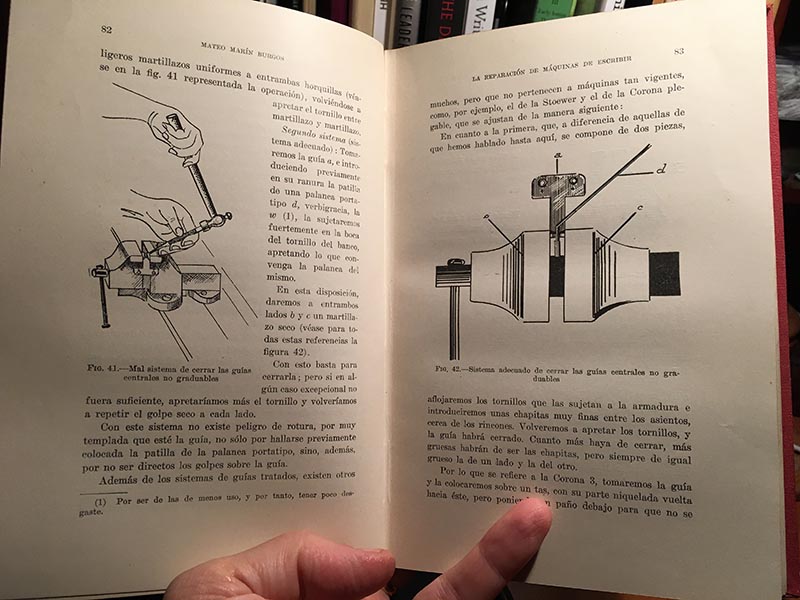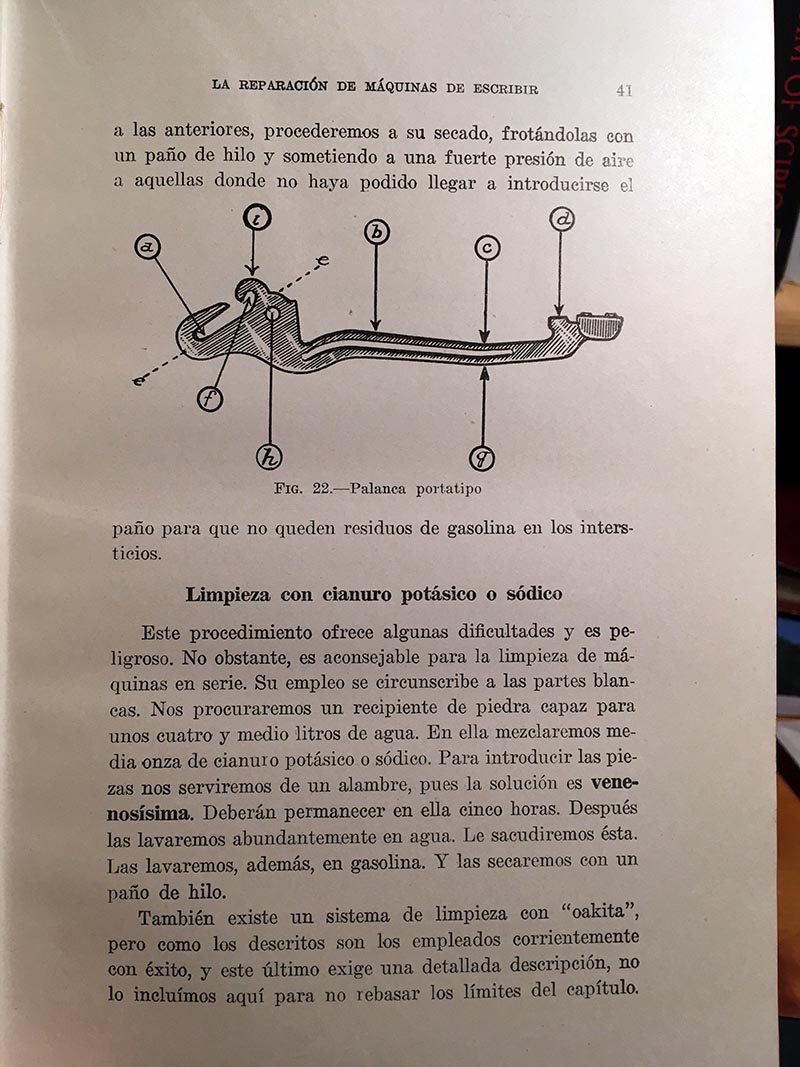I've found the perfect go-with for my Hispano-Olivetti M40.
The second edition of La reparación de máquinas de escribir, by Mateo Marín Burgos, was published in Madrid in 1936, just at the beginning of the Spanish Civil War.
This second edition has a special section on the Hispano-Olivetti M40, with the help and blessing of Olivetti — a wise addition to keep the book up to date, since in the 1930s this excellent model had become the Spanish typewriter of choice.
In the introduction, Marín comes across as a literate expert with a certain amount of justified pride.
"We want to block certain professional criticisms, more or less malevolent, directed against the supposed inefficacy of our work—a simple glance at which, of course, does not permit one to go shooting out with a tool case to repair in a trice the first machine that gets thrown in one's face.
"No, dear friends, no. A technical book to be studied is not a novel. We have never yet known a case of someone who, upon closing a book on astronomy, physics, or mathematics, has been turned into an astronomer, a physicist, or a mathematician."
The book begins with history—the story of the Sholes & Glidden, for those who want to know who "the" inventor of "the" typewriter was, followed by a more thorough history going back to Henry Mill (1714) and mentioning several 19th-century highlights. There is nothing original here, there are many omissions, and there are some misspellings and errors—but on the whole, Marín does a very good job, considering that this is not a history book and that it wasn't so easy to find sources on typewriter history at the time.
Lots of text and illustrations follow, especially on the Underwood — a wise choice, considering the dominance of the Underwood before the Hispano-Olivetti M40 conquered Spain. But quite a few other brands, including Remington and Woodstock, are discussed. There is even some discussion of Hammonds. Many procedures have to be described in verbal generalities instead of being illustrated in detail, since it would be impossible for a single book to cover every repair on every typewriter.
Here, oddly, Marín illustrates both a "bad" and an "appropriate" way of tightening a type guide.
In the illustration below, Marín recommends making a segment-cleaning tool by cutting an Underwood typebar along the line e------e. Of course, a typebar will fit into a segment slot. Clever!
Later in the book, he recommends making what he describes as a very useful and efficient tool for removing key rings by cutting off the protrusion on the left side of the typebar as illustrated below, but leaving a curved hook (d). Then this tool has two hooks that will easily pry off a key ring. I'll have to try this sometime.
This same page recommends gasoline and potassium cyanide as cleaning agents, with a warning that the latter is "very poisonous." I've seen cyanide recommended in an American book on typewriter repair, too.
These illustrations show you how to solder type and perform an alignment.
Finally we reach the new section all about the M40, with illustrated instructions on how to disassemble and reassemble the machine. We learn that the model "has 3,061 parts, 945 of which are different. 21,427 operations are required for its manufacture. ... The greatest tolerances admitted in its moving parts are of two hundredths of a millimeter." This should be enough to make anyone considering building a new typewriter today take the challenge seriously.
A final section includes various "interesting facts," such as diagrams of a variety of typebar mechanisms. Here we see the frontstroke Yost, the Williams, the Bar-Lock, the Typo, the Noiseless, and the Empire. Some of these were considered obsolete by 1936, but the memory of them evidently had not faded completely, and it was still possible that someone would bring in something like a Williams for repair.
As if this weren't enough, Marín provides very helpful lists of platen dimensions, ribbon widths, and weights for a wide variety of typewriters, including some very obscure ones that are new to me (Naco? Atlantia? Miniature? Menier?). He provides addresses for "the principal typewriter manufacturers," including some old and not-so-principal ones (the Belka and Saturn were made by Bruno Lange in Karlsruhe, he says).
Are you eager to get your hands on this book? I can find just one other copy for sale at the moment.
Although my H-O M40 is working perfectly at the moment, I will keep Marín's book by its side as a trusty companion.


















Nice acquisition! (:
ReplyDeleteWonderful book. Beautiful typewriter.
ReplyDeleteI never learned much Spanish. Mrs. M would need to read such a book to me.
I have one Olivetti M40, too. They're beautiful machines.
ReplyDeleteYo lo quiero. <3
ReplyDelete